

Controlling Indoor Humidity. Controlling Indoor Humidity Step outside on a summer day, and it's easy to feel the effects of humidity -- sticky skin, a sweaty brow, air thick with moisture.

But when it comes to humidity inside, those tell-tale signs are replaced by itching, sneezing and coughing, and they're not limited to the summer months. Humidity makes you sneeze The word humidity refers to the amount of water vapor in the air. 3.3 Design for warm-humid zones. (introduction...) 3.0 Design methodology3.1 General guidelines3.2 Design for Hot-arid zones3.3 Design for warm-humid zones3.4 Design for temperate and upland zones 3.0 Design methodology The main points:· Collect information about the local climate factors and the requirements of the user.· Analyse this information.· Develop the appropriate design concept.

This Green House: Passive Air Conditioning. I occasionally use this column to investigate relatively simple methods to make homes more environmentally sustainable.

This can begin with questions of design, so that a home makes the best possible use of natural light, or questions of construction, like selecting materials and building methods that minimize environmental impact. In , residential electricity usage accounts for nearly a third of energy consumption. As a result, reducing household energy consumption would have a significant impact on improving the overall environment.
At present, it would do so primarily by decreasing the damage caused by the extraction, transportation and conversion of fossil fuels to electricity: establishing policies that promote renewable energy production is another discussion to be saved for another day. A major use of electricity for businesses and households in ’s semi-arid climate, especially during the summer months, is for air conditioning. How to Build a Geothermal Heat Exchange for a Solar Chimney. Over the last few years, the use of a solar chimney has been increasing in popularity due to the growing concern about global warming and pollution.
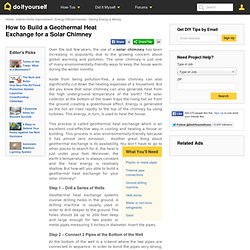
Why Foam It Green® is Green. Many of our customers want green building materials.

We're very thankful for the large increase in rising standards because saving energy, saving money, and saving the planet are all related. Foam It Green spray foam kits are classified as green because: Our spray foam kits stop tremendous amounts of energy waste by sealing out air leaks.Foam It Green has a high r-value of 7 in just 1 inch.Guardian Energy Technologies, Inc. has balanced its carbon footprint by sponsoring clean energy and carbon reduction projects through TerraPass.Foam It Green minimizes transportation impact because it is 100% American Made and ships from our location in Chicagoland, Illinois.
Natural ventilation - stack ventilation. Provided by Nick Baker: Research Associate, The Martin Centre, University of Cambridge What, Why, When, How, Extras.
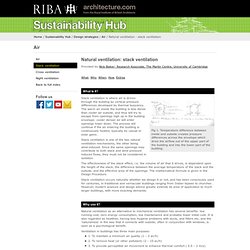
How to Install Vents in a Solar Chimney. A solar chimney can cool your home and save you money.
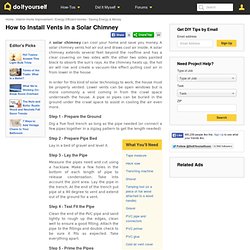
A solar chimney vents hot air out and draws cool air inside. Solar chimney. This article refers to a device for ventilation.

For the power generation technology, see Solar updraft tower. The solar chimney has been in use for centuries, particularly in the Middle east and Near East by the Persians, as well as in Europe by the Romans. Description[edit] Trombe wall. Passive solar design using an unvented Trombe wall and summer shading A Trombe wall is a passive solar building technique where a wall is built on the winter sun side of a building with a glass external layer and a high heat capacity internal layer separated by a layer of air.
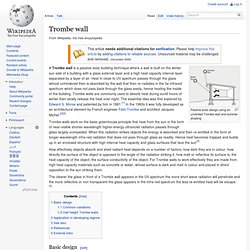
Heat in close to UV spectrum passes through the glass almost unhindered then is absorbed by the wall that then re-radiates in the far infrared spectrum which does not pass back through the glass easily, hence heating the inside of the building. Trombe walls are commonly used to absorb heat during sunlit hours of winter then slowly release the heat over night. The essential idea was first explored by Edward S. Morse and patented by him in 1881.[1] In the 1960s it was fully developed as an architectural element by French engineer Félix Trombe and architect Jacques Michel.[2][3] Basic design[edit]
Concrete Footer Part 1. How to Build a Concrete Block Wall By Sakrete. Brettstapel: another way of building with wood. Kennedy & Violich described the building material in the Soft House as " a traditional solid wood panel and deck construction with wood dowel joints.
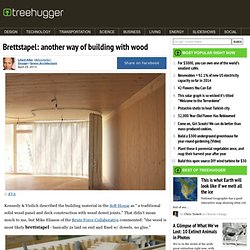
" Hydronic Cooling - Oikos. In recent years, there has been a resurgence of interest in hydronic heating, especially in the form of radiant floors. While interest has been high, hydronic heating is gaining only a tiny share of the market. Ironically, it's the lack of a cooling method that has limited hydronic heating in the marketplace. Even in heating-dominated climates, cooling has become a standard feature of new homes. Many home buyers can't justify the cost of adding a complete duct system to provide cooling. Recent developments in hydronic cooling promise to remove this limitation. Hydronic comfort systems offer several advantages over forced air. These advantages support the idea that thermal comfort could be provided by a hydronic system, while indoor air quality and moisture control could be provided by a much smaller fresh air ventilation system.
Types of Hydronic Cooling Residential and commercial buildings can incorporate hydronic cooling in several ways. Build Your Own Earth Oven » FreestyleFarm. Quick! Rocket stove mass heater. Root Cellar. Living with less, but only the best. When I say that I sleep on a futon, people automatically assume it’s one of those hard, cheap Ikea-for-students futons. On the contrary, because what I use is a good Japanese futon. (Where to buy a Japanese-style futon in North America) Put your stuff up in the air! Hanging DIY ideas & tutorials. Posted by ScrapHacker.com on onsdag, juni 27, 2012 · 9 Comments. Radiant Floor Heating. What Is The Tiny House Movement?
What are tiny houses? The tiny house movement? Tiny living? Simply put, it is a social movement where people are choosing to downsize the space they live in. The typical American home is around 2,600 square feet, whereas the typical small or tiny house is between 100 and 400 square feet. Tiny houses come in all shapes, sizes, and forms, but they enable simpler living in a smaller, more efficient space. People are joining this movement for many reasons, but the most popular reasons include environmental concerns, financial concerns, and the desire for more time and freedom. Historic Houseparts.